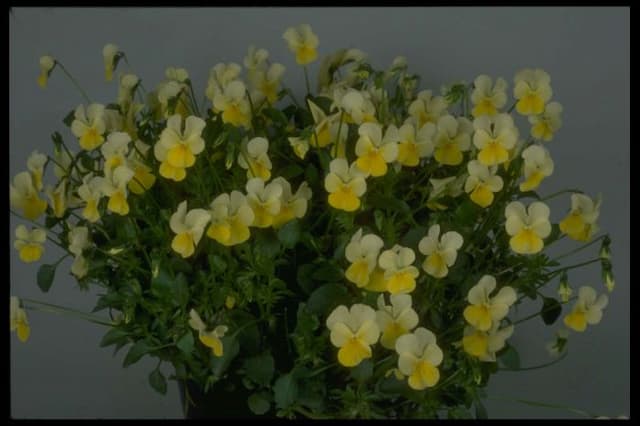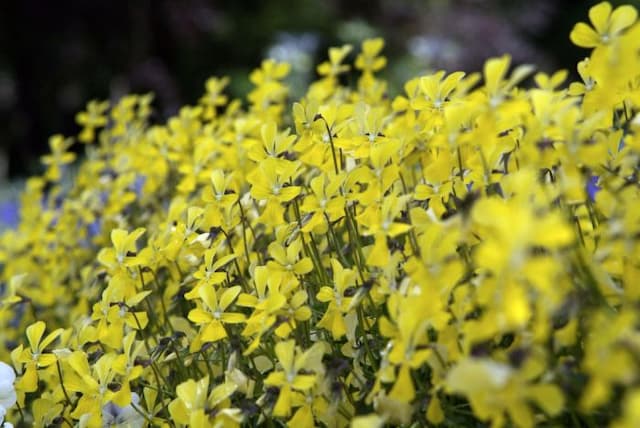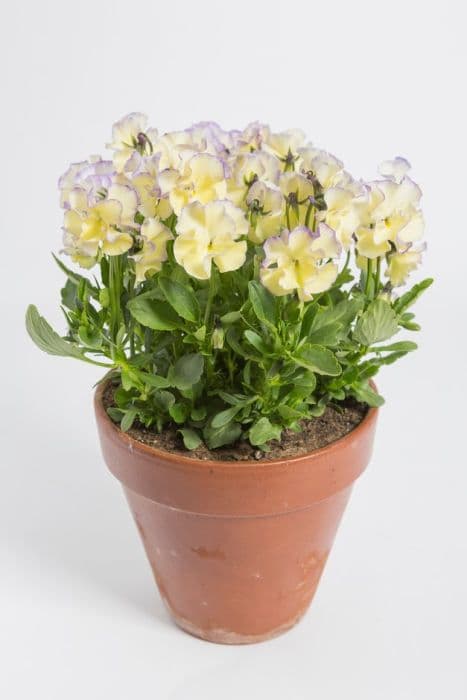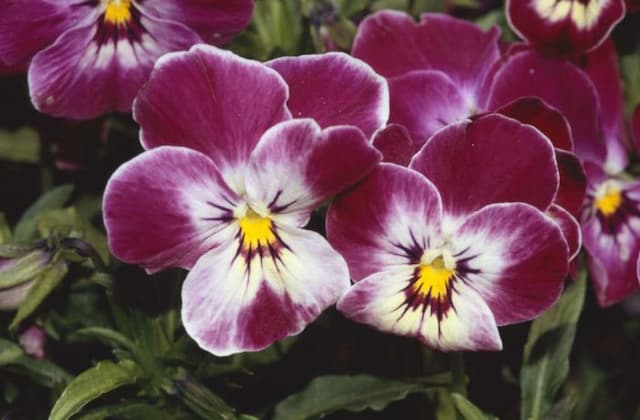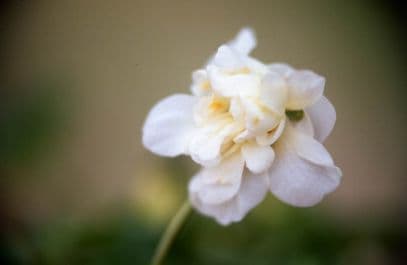Pansy Viola 'Frilly Dilly'

ABOUT
The Viola 'Frilly Dilly' is a charming cultivar known for its distinctively attractive flowers. The blooms feature a wavy or frilly edge, giving them a ruffled appearance that is both delicate and whimsical. In terms of color, the flowers can exhibit a rich array of shades, often a blend of purples, blues, and yellows, which is typical of many viola varieties. This intricate color pattern may include a face-like center, commonly seen in pansies, with darker lines radiating from the center like whiskers. These lines serve to guide pollinators to the heart of the flower. The petals themselves are velvety to the touch and slightly overlapping. The foliage of the Viola 'Frilly Dilly' is usually a vibrant green, forming a dense mound or tuft beneath the flowers. The leaves are typically heart-shaped or rounded with slight serration at the edges, adding to the plant's overall lush appearance. The leaves and flowers sprout from a central point, creating a clustered, yet organized look. Although the size of the plant is not to be detailed, it is often proportionate to the size of the blooms, which are characteristic of the viola family. Overall, the Viola 'Frilly Dilly', with its fanciful flowers and bright foliage, is a delightful addition to any space that aims to invoke a touch of natural whimsy and color.
About this plant
 Names
NamesSynonyms
Frilly Dilly Pansy, Frilled Pansy.
Common names
Viola cornuta 'Frilly Dilly'.
 Toxicity
ToxicityTo humans
Violas, including the 'Frilly Dilly' variety, are generally considered non-toxic to humans. They are often used in culinary applications, such as salad garnishes and cake decorations. Consuming them in normal food quantities is usually safe, and there are no common symptoms of poisoning associated with violas. However, it's always wise to exercise caution and ensure plants haven't been treated with pesticides or other chemicals before ingestion.
To pets
Violas, including the 'Frilly Dilly' variety, are also generally considered non-toxic to pets. They are not known to cause harm to dogs or cats if ingested. While ingestion might cause mild gastrointestinal upset in some pets, serious symptoms of poisoning are unlikely. As with any non-food item, if a pet consumes a large amount of the plant, it is advisable to monitor them for any signs of discomfort or illness and consult a veterinarian if any adverse reactions occur.
 Characteristics
CharacteristicsLife cycle
Perennials
Foliage type
Evergreen
Color of leaves
Green
Flower color
Mixed
Height
4-6 inches (10-15 cm)
Spread
6-8 inches (15-20 cm)
Plant type
Herb
Hardiness zones
5
Native area
Europe
Benefits
 General Benefits
General Benefits- Aesthetic Appeal: Adds a touch of whimsy to gardens with its unique frilled petals and vibrant colors.
- Extended Blooming Season: Pansies are known for their long flowering period which can last from spring through fall in suitable climates.
- Cold Tolerance: As a pansy variety, 'Frilly Dilly' can withstand cooler temperatures, making it ideal for early spring and late fall planting.
- Low Maintenance: Requires minimal care once established, making it suitable for novice gardeners or those with limited time.
- Attracts Pollinators: Invites beneficial insects such as bees and butterflies into the garden, helping with the pollination of plants.
- Versatility: Can be grown in flower beds, containers, and even as border plants, offering flexibility in garden design.
- Color Variety: Offers a range of colors, enhancing the overall palette of the garden or landscape.
- Edibility: Some pansy varieties, including Viola 'Frilly Dilly', have edible flowers that can be used to garnish salads, desserts, and drinks.
 Medical Properties
Medical PropertiesThis plant is not used for medical purposes.
 Air-purifying Qualities
Air-purifying QualitiesThis plant is not specifically known for air purifying qualities.
 Other Uses
Other Uses- Edible Decorations: The flowers of the Viola 'Frilly Dilly', also known as pansies, can be crystallized with egg whites and sugar to create beautiful edible garnishes for desserts and cakes.
- Natural Dye: Pansies can be used to create natural dyes for fabrics or paper, lending them a soft yellow, green, or blue hue depending on the flower color.
- Photography Subject: Due to their unique frilly appearance, pansies make an interesting subject for macro photography, allowing photographers to experiment with depth and texture.
- Garden Design: The 'Frilly Dilly' variety, with its distinctive ruffled edges, can be used in garden design to create a contrasting texture amidst smooth-leaved plants.
- Eco-friendly Confetti: Dried pansy petals can serve as a biodegradable confetti option for outdoor celebrations, reducing the environmental impact of such events.
- Tea Garnishes: Fresh or dried pansy flowers can be used to garnish tea blends, adding visual appeal to the presentation of herbal teas.
- Floral Ice Cubes: Pansy blooms can be frozen into ice cubes to add a touch of elegance to cold beverages or punch bowls during spring and summer events.
- Art and Craft: Pressed pansy flowers can be used in scrapbooking or to create botanical art pieces, bookmarks, or greeting cards.
- Plant Dye for Artwork: Extracts from the pansy flowers can be used by artists as a natural pigment for watercolor paintings or fabric art.
- Children’s Learning Tool: The diverse colors of pansy flowers make them a useful tool for teaching children about nature, color variations, and plant biology.
Interesting Facts
 Feng Shui
Feng ShuiThe pansy is not used in Feng Shui practice.
 Zodiac Sign Compitability
Zodiac Sign CompitabilityThe pansy is not used in astrology practice.
 Plant Symbolism
Plant Symbolism- Loveliness: Violas, commonly known as "pansies," have long been a symbol of thoughtfulness and love. The 'Frilly Dilly' variety, with its delicate petals, represents an even greater depth of loveliness due to its unique appearance.
- Remembrance: Pansies are often associated with remembrance and the act of reflection, suggesting that a person keeps fond memories and thoughts of their loved ones.
- Free thinking: Arising from its etymological links to the French word "pensée" (meaning "thought"), pansies symbolize free thinking and the freedom of the mind to ponder and reflect.
- Innocence: As with many flowers, the pansy also carries connotations of innocence due to its delicate and unassuming structure.
- Fun and Cheerfulness: With its bright and varied colors, the Viola 'Frilly Dilly' exudes a sense of joy and playfulness, which is a common symbolic meaning attributed to pansies.
 Water
WaterPansies, including the Viola 'Frilly Dilly', prefer consistently moist soil, so water when the top inch of soil feels dry to the touch. Usually, this means watering once or twice a week, depending on weather conditions. Ensure even moisture by watering gently at soil level to avoid displacing the soil or damaging the delicate flowers. A good rule of thumb is to provide about one to two gallons of water per square foot every week, adjusting for rainfall and changes in temperature that may affect the plant's needs.
 Light
LightPansies, like the Viola 'Frilly Dilly', thrive in full to partial sunlight. The ideal spot offers morning sun and afternoon shade, especially in areas with hot afternoons. They perform best with at least 6 hours of direct sunlight each day.
 Temperature
TemperaturePansies, such as the Viola 'Frilly Dilly', prefer cool temperatures and will flourish in environments where temperatures remain between 40 to 60 degrees Fahrenheit. They can withstand a frost and survive short periods at temperatures as low as 20 degrees Fahrenheit, but prolonged exposure to temperatures above 80 degrees may cause them to falter.
 Pruning
PruningPansies, which include the Viola 'Frilly Dilly', should be deadheaded regularly to promote continuous blooming. Remove spent flowers to encourage new growth. The best time to prune is in the evening or on an overcast day to prevent stress to the plant.
 Cleaning
CleaningAs needed
 Soil
SoilThe best soil mix for the common pansy (Viola 'Frilly Dilly') is a well-draining, loamy soil with added organic matter like compost. The soil pH should be slightly acidic to neutral, in the range of 6.0 to 7.0 for optimal growth.
 Repotting
RepottingPansies typically do not require frequent repotting. It's recommended to repot the plant once every 1-2 years or when it outgrows its current container.
 Humidity & Misting
Humidity & MistingPansies prefer moderate humidity levels; however, they can tolerate a wide range of conditions. Aim for a humidity level of about 40-60%.
 Suitable locations
Suitable locationsIndoor
Place in bright, indirect light with moist soil.
Outdoor
Use well-draining soil, partial shade to full sun.
Hardiness zone
4-8 USDA
 Life cycle
Life cycleThe life of a Viola 'Frilly Dilly', commonly known as a Frilly Dilly Pansy, begins with seed germination, where under appropriate conditions of moisture and temperature, the seed will sprout and develop into a small seedling. This is followed by a vegetative growth stage where the seedling develops true leaves and roots, growing into a mature plant. During this stage, the Frilly Dilly Pansy forms its distinctive foliage and begins to establish itself. As it enters the flowering stage, the plant starts to produce vibrant and frilly flowers, which is a unique characteristic of this cultivar and typically occurs in cooler months. Following pollination, whether by insects or self-pollination, the plant then produces seeds, completing the reproductive stage of its life cycle. Eventually, as a perennial, it will enter a period of dormancy during harsh conditions, only to regrow from its root system with the return of favorable weather.
 Propogation
PropogationPropogation time
Spring to Summer
Propogation: The Viola 'Frilly Dilly', commonly known as a type of Pansy, is often propagated through seeds. The best time to sow Pansy seeds is in late winter or early spring for planting out after the last frost. To propagate Pansies from seed, fill a tray with moist, well-draining seed-starting mix. Sprinkle the tiny seeds on top of the mix, then lightly press them into the soil. It's not necessary to cover them with soil as they need light to germinate. Keep the soil moist but not waterlogged and maintain a temperature around 65 to 70 degrees Fahrenheit (18 to 21 degrees Celsius). Germination typically occurs within 1 to 2 weeks. Once seedlings emerge and have developed a couple of true leaves, they can be transplanted into individual pots or directly into the garden if conditions permit.

